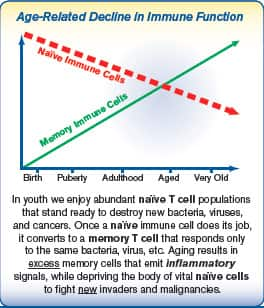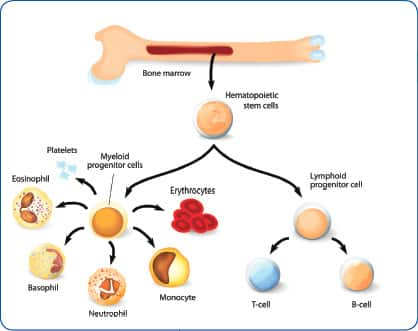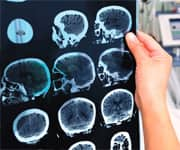Life Extension Magazine®

A startling change occurs around age 65 that decimates our ability to combat infections and malignancies.
This catastrophic event decreases naïve T cells needed to ward off new bacteria, viruses, and cancers. The chart on this page shows how production of these vital immune cells sharply declines as we age.
At the same time naïve T cells are lost, we accumulate senile memory T cells that emit pro-inflammatory signals that wreak havoc in every organ system.1
One of the most deadly of these inflammatory “signals” is a cytokine called interleukin-6 (IL-6).2
Higher IL-6 levels are associated with a 2-fold greater risk of death.3 Higher levels are also involved with multiple degenerative processes including frailty that so many elderly suffer.4-7 A common trait of healthy centenarians is that they have unusually low levels of IL-6.8
People associate immune senescence with weakened immune function. It turns out that impaired immunity is only half the problem. Spiraling levels of IL-6 that attack our healthy tissues are another component of immune senescence that must be addressed.9

The encouraging news is that significant dollars are being invested to develop technologies to turn back “on” youthful immune function.10 These immune-restoration therapies will likely add decades to our healthy life spans.
The problem is that many of us can’t wait for bureaucratic delays while our immune systems fall off a cliff. This article will explain what Life Extension® is doing to accelerate restoration of immune competence in aging humans today, including suppressing deadly interleukin-6 levels.
Immune senescence is a leading cause of disability and death in aging humans.11
By way of example, deaths from pneumonia are rare in youth, but spiral upwards as humans mature.12 If you read obituaries (as I do), the number of once-vigorous individuals who perish from opportunistic illnesses caused by immune senescence is startling.
One year ago, Life Extension Magazine® published in-depth reports about underlying causes of immune senescence and what stop-gap measures people should initiate to reverse this deadly trend.13-15
In people over age 65, the top 10 causes of death include influenza, pneumonia, and sepsis.16 Immune senescence is a major cause of all these maladies.12,17-22
Cancer, stroke, Alzheimer’s, and heart attack are common diseases of aging.16 These illnesses are all related to immune senescence.
At this time of year, we often hear the term “immune health” as people seek to protect against viral infections. The public does not yet understand what causes our immune system to fail as we age.
More Naïve T Cells Urgently Needed
Immune imbalance occurs when our aging immune system fails to protect against new cancers/infections, and instead generates inflammatory reactions (including increased IL-6) that attack every cell in our body.
A “naïve” immune cell is one that has not yet been activated.23 Since it is “naïve” (not yet exposed to an antigen), naïve immune cells are primed to effectively respond to new infectious agents and malignancies.
Once exposed, naïve immune cells become memory cells or plasma cells specific to the original antigen. As our internal reservoir of naïve immune cells is decreased, we have less ability to respond to new infections/malignancies.23
A deficit of naïve immune cells combined with overaccumulation of exhausted memory cells decreases the efficacy (antibody response) of vaccinations.24
Exhausted memory T cells are associated with increased risks of coronary heart disease, impaired vascular function, and endothelial dysfunction, along with systemic inflammation.25-30
If we are to guard against the ravages of immune senescence, we need to increase our numbers of naïve cells (“virgin” immune cells), while reducing numbers of senile memory cells.
Protecting against Immune Senescence Today
Most Life Extension® customers take nutrients that exert beneficial effects on immune activity.
Zinc and DHEA partially restore thymus function, which is vital to transforming bone marrow-derived immune cells into activated T cells.31-35 DHEA and fish oil help suppress deadly interleukin-6.36-41
A major advance announced last year in combatting immune senescence is an herb called Cistanche. This medicinal plant has been used extensively in China to treat the “ailments of aging.”42
Supplementation with Cistanche has been shown to increase naïve T cells and natural killer (NK) cells while decreasing memory T cells and pro-inflammatory interleukin-6.43 One of the characteristics of people who live over 100 years is low levels of interleukin-6.8
A prime cause of the severe immune dysfunction suffered by the elderly is a marked decrease in naïve T cells44-46 and functional natural killer cells,47-49 with a concomitant increase in memory T cells.50,51
Cistanche counteracts these pathological trends that characterize immune senescence.43
“We conclude that CHF (chronic heart failure) patients show a higher degree of immunosenescence than age-matched healthy controls. T-lymphocyte differentiation and IL-6 levels are increased in patients with an advanced clinical status and may contribute to disease impairment through a compromised adaptive immune response due to accelerated aging of their immune system.”
Publication: International Journal of Cardiology – July 1, 2014
Article title: Immunosenescence and inflammation characterize chronic heart failure patients with more advanced disease.
How Cistanche Boosts T Cell Production and Healthy Longevity
Cistanche helps restore progenitors of peripheral naïve T cells, which explains the increase seen in these vital immune cells in response to Cistanche.43
Animals supplemented with Cistanche have increased life spans, which would be expected by a compound that counteracts immune senescence.43
Cistanche is one of the most popular Chinese herbal medicines and is listed in the Chinese herbal pharmacopeias as having “anti-aging” properties.
One reason Chinese physicians see such impressive therapeutic results is that Cistanche restores one of the most prominent bone marrow biomarkers of immune cell formation called stem cell antigen-1.43

Senile bone marrow loses its ability to produce fresh naïve immune cells, which are launched into the bloodstream to differentiate into mature naïve T and natural killer cells. Bone marrow stem cell antigen-1 represents the body’s main source of naïve T cells in the blood.43 Cistanche appears to have a rejuvenating effect on the bone marrow, something that is generally only available through expensive recombinant drugs.52-54
The beneficial impact of Cistanche was demonstrated in an open-label pilot trial of elderly people. This study combined a low-dose of Cistanche (100 mg) with zinc, vitamin E, vitamin B6, fucoidan, and coenzyme Q10. Not only were markers of immune senescence reversed, but the test subjects reported improvements in quality of life, such as not “feeling tired all the time.” This makes sense in light of the multiple adverse effects immune senescence inflicts on the body, which includes increased levels of frailty.55,56
There are other factors that weaken immune function in the elderly that Cistanche has been shown to counteract. These will be described in depth in the article beginning on page 34 of this month’s issue.
Cistanche represents an important advance in our ability to restore vital components of our aging immune systems. Its low cost makes it readily affordable.
Suppressing Deadly Impact of IL-6
One way of describing “aging” is that beneficial factors (such as naïve T cell production) decrease while detrimental ones (like interleukin-6) increase.
IL-6 levels are especially high in patients with autoimmune conditions where an out-of-control immune system attacks one’s own tissues. High serum IL-6, as seen in rheumatoid arthritis, for instance, is regarded as a reliable biomarker of high-grade inflammation.57-59
When it comes to “normal” aging, elevated IL-6 contributes to the chronic destruction of our bone, heart valves, neurons, and other tissues, while the DNA damage it inflicts accelerates aging processes and malignant transformation of healthy cells.60-66
Life Extension® has published a number of articles over the past several decades about the critical need for aging humans to suppress chronic inflammatory inducers like interleukin-6.
I am pleased to announce that a potent new weapon to reduce IL-6 has been added to an immune-restoration formula that many of our customers take daily. The cost of this novel tea extract is so low that the price of this blend of beneficial immune nutrients remains the same as last year.
When this tea extract was given by itself to a group of 90 patients (30-65 years) with metabolic syndrome, the following reductions in inflammatory markers were observed:67
- C-reactive protein (CRP) was reduced by 26%
- Tumor necrosis factor (TNF-a) was reduced by 23%
- Interleukin-6 (IL-6) was reduced by 21%
In addition to suppressing IL-6 and other inflammatory factors, this tea extract was shown to favorably alter genes (such as mutant p53) involved in tumor cell growth.68
Making Major Strides…

We are rapidly entering a new paradigm in counteracting age-related disease.
Scientific studies document how certain nutrients that Life Extension® supporters have taken for decades (like DHEA and zinc) help protect against immune decline, while guarding against chronic inflammatory factors.70-75
Consumers now have access to an arsenal of novel compounds to counteract the underlying factors that characterize immune senescence.
An impressive array of clinical research is being investigated to induce systemic age reversal in elderly humans by utilizing bone marrow-mobilized factors from young blood donors.76
Your purchases of these nutrient formulas from Life Extension® help to fund avant-garde research at prestigious medical facilities aimed at gaining control over pathological aging processes.
Obtain Latest Formulas at Year’s Lowest Prices
This is the time of year when we discount prices on every one of our advanced nutritional formulas. Longtime supporters know to take advantage of this once-a-year Super Sale to stock up on their favorite supplement formulas.
What should comfort supporters more than anything else are the three novel methods to counteract aging we have introduced over the past 12 months.
One involves activating a cellular enzyme (AMPK) that declines with aging and is responsible for myriad of age-related disorders.
The second (introduced three weeks ago) suppresses an enzyme (MAO-B) that accelerates brain aging and causes maturing people to lose their sense of well-being.
The third is an enhancement to an immune-protection formula that suppresses deadly inflammatory factors such as IL-6, TNF-a, and C-reactive protein.
Inflammatory Markers Predict Human Mortality
 |
A study of community-dwelling people over age 80 was done to investigate whether interleukin-6 (IL-6), C-reactive protein (CRP), and tumor necrosis factor-alpha (TNF-a) levels predict all-cause mortality.
Baseline levels of these inflammatory markers were taken and the subjects followed up for a period of four years.
After adjusting for potential confounders, those with high levels of IL-6 were 2.18 times more likely to die, while study subjects with high CRP were 2.58 times more likely to die.
While TNF-a by itself did not increase mortality rates, those with all three inflammatory markers above the median had the highest mortality risk during the four-year study period. The doctors who conducted this study concluded:
“Low levels of inflammatory markers are associated with better survival in elderly, independently of age and other clinical and functional variables.” 69
Our Commitment to Your Health
No organization is more dedicated to combatting disease, senescence, and premature mortality than Life Extension®. Your support via supplement purchases enables us to contribute to scientists involved in unprecedented biomedical research endeavors.
To order nutrients you need today at Super Sale prices, call 1-800-544-4440.
Editor’s Note:
Science continues to evolve, and new research is published daily. As such, we have a more recent article on this topic: When Your Immune Function Falls.
For longer life,
William Faloon
References
- Available at: http://onlinelibrary.wiley.com/doi/10.1046/j.1365-2567.2002.01447.x/epdf. Accessed October 9, 2015.
- Scheller J, Chalaris A, Schmidt-Arras D, et al. The pro- and anti-inflammatory properties of the cytokine interleukin-6. Biochim Biophys Acta. 2011;1813(5):878-88.
- Harris TB, Ferrucci L, Tracy RP, et al. Associations of elevated interleukin-6 and C-reactive protein levels with mortality in the elderly. Am J Med. 1999;106(5):506-12.
- Ferrucci L, Harris TB, Guralnik JM, et al. Serum IL-6 level and the development of disability in older persons. J Am Geriatr Soc. 1999;47(6):639-46.
- Hubbard RE, O’Mahony MS, Savva GM, et al. Inflammation and frailty measures in older people. J Cell Mol Med. 2009;13(9b):3103-9.
- Ershler WB, Keller ET. Age-associated increased interleukin-6 gene expression, late-life diseases, and frailty. Annu Rev Med. 2000;51:245-70.
- Maggio M, Guralnik JM, Longo DL, et al. Interleukin-6 in aging and chronic disease: a magnificent pathway. J Gerontol A Biol Sci Med Sci. 2006;61(6):575-84.
- Franceschi C, Olivieri F, Marchegiani F, et al. Genes involved in immune response/inflammation, IGF1/insulin pathway and response to oxidative stress play a major role in the genetics of human longevity: the lesson of centenarians. Mech Ageing Dev. 2005;126(2):351-61.
- Simpson EE, Hodkinson CF, Maylor EA, et al. Intracellular cytokine production and cognition in healthy older adults. Psychoneuroendocrinology. 2013;38(10):2196-208.
- Available at: http://www.sens.org/sites/srf.org/files/reports/SENS%20Research% 20Foundation%20Annual%20Report%202015.pdf. Accessed October 9, 2015.
- High KP, Akbar AN, Nikolich-Zugich J. Translational research in immune senescence: assessing the relevance of current models. Semin Immunol. 2012;24(5):373-82.
- Shivshankar P, Boyd AR, Le Saux CJ, et al. Cellular senescence increases expression of bacterial ligands in the lungs and is positively correlated with increased susceptibility to pneumococcal pneumonia. Aging Cell. 2011;10(5):798-806.
- Available at: https://www.lifeextension.com/magazine/2015/2/major-advance-in-slowing-aging/page-01. Accessed October 9, 2015.
- Available at: https://www.lifeextension.com/magazine/2015/1/activate-your-natural-killer-cells/page-01. Accessed October 9, 2015.
- Available at: https://www.lifeextension.com/magazine/2015/1/how-immune-decline-hastens-aging/page-01. Accessed October 9, 2015.
- Available at: http://www.cdc.gov/nchs/data/ahcd/agingtrends/01death.pdf. Accessed October 9, 2015.
- Bartling B. Cellular senescence in normal and premature lung aging. Z Gerontol Geriatr. 2013;46(7):613-22.
- Glennie SJ, Sepako E, Mzinza D, et al. Impaired CD4 T cell memory response to Streptococcus pneumoniae precedes CD4 T cell depletion in HIV-infected Malawian adults. PLoS One. 2011;6(9):e25610.
- Hernandez-Vargas EA, Wilk E, Canini L, et al. Effects of aging on influenza virus infection dynamics. J Virol. 2014;88(8):4123-31.
- Zhou X, McElhaney JE. Age-related changes in memory and effector T cells responding to influenza A/H3N2 and pandemic A/H1N1 strains in humans. Vaccine. 2011;29(11):2169-77.
- Opal SM, Girard TD, Ely EW. The immunopathogenesis of sepsis in elderly patients. Clin Infect Dis. 2005;41 Suppl 7:S504-12.
- Vollmar B, Pradarutti S, Nickels RM, et al. Age-associated loss of immunomodulatory protection by granulocyte-colony stimulating factor in endotoxic rats. Shock. 2002;18(4):348-54.
- Available at: http://www.ncbi.nlm.nih.gov/books/nbk27090. Accessed October 9, 2015.
- Weinberger B, Herndler-Brandstetter D, Schwanninger A, et al. Biology of immune responses to vaccines in elderly persons. Clin Infect Dis. 2008;46(7):1078-84.
- Wehrens EJ, Prakken BJ, van Wijk F. T cells out of control--impaired immune regulation in the inflamed joint. Nat Rev Rheumatol. 2013;9(1):34-42.
- Nakajima T, Schulte S, Warrington KJ, et al. T-cell-mediated lysis of endothelial cells in acute coronary syndromes. Circulation. 2002;105(5):570-5.
- Terrazzini N, Bajwa M, Vita S, et al. A novel cytomegalovirus-induced regulatory-type T-cell subset increases in size during older life and links virus-specific immunity to vascular pathology. J Infect Dis. 2014;209(9):1382-92.
- Olson NC, Doyle MF, Jenny NS, et al. Decreased naive and increased memory CD4(+) T cells are associated with subclinical atherosclerosis: the multi-ethnic study of atherosclerosis. PLoS One. 2013;8(8):e71498.
- Ammirati E, Cianflone D, Vecchio V, et al. Effector Memory T cells Are Associated With Atherosclerosis in Humans and Animal Models. J Am Heart Assoc. 2012;1(1):27-41.
- Dumitriu IE, Araguas ET, Baboonian C, et al. CD4+ CD28 null T cells in coronary artery disease: when helpers become killers. Cardiovasc Res. 2009;81(1):11-9.
- Filipin Mdel V, Caetano LC, Brazao V, et al. DHEA and testosterone therapies in Trypanosoma cruzi-infected rats are associated with thymic changes. Res Vet Sci. 2010;89(1):98-103.
- May M, Holmes E, Rogers W, et al. Protection from glucocorticoid induced thymic involution by dehydroepiandrosterone. Life Sci. 1990;46(22):1627-31.
- Mitchell WA, Meng I, Nicholson SA, et al. Thymic output, ageing and zinc. Biogerontology. 2006;7(5-6):461-70.
- Wong CP, Song Y, Elias VD, et al. Zinc supplementation increases zinc status and thymopoiesis in aged mice. J Nutr. 2009;139(7):1393-7.
- Dardenne M, Boukaiba N, Gagnerault MC, et al. Restoration of the thymus in aging mice by in vivo zinc supplementation. Clin Immunol Immunopathol. 1993;66(2):127-35.
- Maes M, Christophe A, Bosmans E, et al. In humans, serum polyunsaturated fatty acid levels predict the response of proinflammatory cytokines to psychologic stress. Biol Psychiatry. 2000;47(10):910-20.
- Khalfoun B, Thibault F, Watier H, et al. Docosahexaenoic and eicosapentaenoic acids inhibit in vitro human endothelial cell production of interleukin-6. Adv Exp Med Biol. 1997;400b:589-97.
- Moon Y, Pestka JJ. Deoxynivalenol-induced mitogen-activated protein kinase phosphorylation and IL-6 expression in mice suppressed by fish oil. J Nutr Biochem. 2003;14(12):717-26.
- Shi Y, Pestka JJ. Mechanisms for suppression of interleukin-6 expression in peritoneal macrophages from docosahexaenoic acid-fed mice. J Nutr Biochem. 2009;20(5):358-68.
- Araghi-Niknam M, Zhang Z, Jiang S, et al. Cytokine dysregulation and increased oxidation is prevented by dehydroepiandrosterone in mice infected with murine leukemia retrovirus. Proc Soc Exp Biol Med. 1997;216(3):386-91.
- Liu S, Ishikawa H, Li FJ, et al. Dehydroepiandrosterone can inhibit the proliferation of myeloma cells and the interleukin-6 production of bone marrow mononuclear cells from patients with myeloma. Cancer Res. 2005;65(6):2269-76.
- Jiang Y, Tu PF. Analysis of chemical constituents in Cistanche species. J Chromatogr A. 2009;1216(11):1970-9.
- Zhang K, Ma X, He W, et al. Extracts of Cistanche deserticola Can Antagonize Immunosenescence and Extend Life Span in Senescence-Accelerated Mouse Prone 8 (SAM-P8) Mice. Evid Based Complement Alternat Med. 2014;2014:601383.
- Pfister G, Weiskopf D, Lazuardi L, et al. Naive T cells in the elderly: are they still there? Ann N Y Acad Sci. 2006;1067:152-7.
- Ferrando-Martinez S, Ruiz-Mateos E, Hernandez A, et al. Age-related deregulation of naive T cell homeostasis in elderly humans. Age (Dordr). 2011;33(2):197-207.
- Fagnoni FF, Vescovini R, Passeri G, et al. Shortage of circulating naive CD8(+) T cells provides new insights on immunodeficiency in aging. Blood. 2000;95(9):2860-8.
- Camous X, Pera A, Solana R, et al. NK cells in healthy aging and age-associated diseases. J Biomed Biotechnol. 2012;2012:195956.
- Beli E, Duriancik DM, Clinthorne JF, et al. Natural killer cell development and maturation in aged mice. Mech Ageing Dev. 2014;135:33-40.
- Hazeldine J, Lord JM. The impact of ageing on natural killer cell function and potential consequences for health in older adults. Ageing Res Rev. 2013;12(4):1069-78.
- Kovaiou RD, Weiskirchner I, Keller M, et al. Age-related differences in phenotype and function of CD4+ T cells are due to a phenotypic shift from naive to memory effector CD4+ T cells. Int Immunol. 2005;17(10):1359-66.
- Wikby A, Maxson P, Olsson J, et al. Changes in CD8 and CD4 lymphocyte subsets, T cell proliferation responses and non-survival in the very old: the Swedish longitudinal OCTO-immune study. Mech Ageing Dev. 1998;102(2-3):187-98.
- Liang HD, Yu F, Tong ZH, et al. Cistanches Herba aqueous extract affecting serum BGP and TRAP and bone marrow Smad1 mRNA, Smad5 mRNA, TGF-beta1 mRNA and TIEG1 mRNA expression levels in osteoporosis disease. Mol Biol Rep. 2013;40(2):757-63.
- Zeng JC, Fan YG, Liu JR, et al. [Experimental study of directional differentiation of bone mesenchymal stem cells (BMSCs) to osteoblasts guided by serum containing cistanche deserticola]. Zhongguo Gu Shang. 2010;23(8):606-8.
- Liang H, Yu F, Tong Z, et al. Effect of Cistanches Herba aqueous extract on bone loss in ovariectomized rat. Int J Mol Sci. 2011;12(8):5060-9.
- van den Biggelaar AH, Huizinga TW, de Craen AJ, et al. Impaired innate immunity predicts frailty in old age. The Leiden 85-plus study. Exp Gerontol. 2004;39(9):1407-14.
- Available at: http://www.anti-aging.gr.jp/english/pdf/2011/8(2)0714.pdf. Accessed October 12, 2015.
- Ishihara K, Hirano T. IL-6 in autoimmune disease and chronic inflammatory proliferative disease. Cytokine Growth Factor Rev. 2002;13(4-5):357-68.
- Yao X, Huang J, Zhong H, et al. Targeting interleukin-6 in inflammatory autoimmune diseases and cancers. Pharmacol Ther. 2014;141(2):125-39.
- Nowell MA, Williams AS, Carty SA, et al. Therapeutic targeting of IL-6 trans signaling counteracts STAT3 control of experimental inflammatory arthritis. J Immunol. 2009;182(1):613-22.
- Rodier F, Coppe JP, Patil CK, et al. Persistent DNA damage signalling triggers senescence-associated inflammatory cytokine secretion. Nat Cell Biol. 2009;11(8):973-9.
- Freund A, Orjalo AV, Desprez PY, et al. Inflammatory networks during cellular senescence: causes and consequences. Trends Mol Med. 2010;16(5):238-46.
- Wei H, Chadman KK, McCloskey DP, et al. Brain IL-6 elevation causes neuronal circuitry imbalances and mediates autism-like behaviors. Biochim Biophys Acta. 2012;1822(6):831-42.
- Quintanilla RA, Orellana DI, Gonzalez-Billault C, et al. Interleukin-6 induces Alzheimer-type phosphorylation of tau protein by deregulating the cdk5/p35 pathway. Exp Cell Res. 2004;295(1):245-57.
- Mahler GJ, Farrar EJ, Butcher JT. Inflammatory cytokines promote mesenchymal transformation in embryonic and adult valve endothelial cells. Arterioscler Thromb Vasc Biol. 2013;33(1):121-30.
- Mathieu P, Bouchareb R, Boulanger MC. Innate and Adaptive Immunity in Calcific Aortic Valve Disease. J Immunol Res. 2015;2015:851945.
- Ishimi Y, Miyaura C, Jin CH, et al. IL-6 is produced by osteoblasts and induces bone resorption. J Immunol. 1990;145(10):3297-303.
- Chu SL, Fu H, Yang JX, et al. A randomized double-blind placebo-controlled study of Pu’er tea extract on the regulation of metabolic syndrome. Chin J Integr Med. 2011;17(7):492-8.
- Zhao L, Jia S, Tang W, et al. Pu-erh tea inhibits tumor cell growth by down-regulating mutant p53. Int J Mol Sci. 2011;12(11):7581-93.
- Giovannini S, Onder G, Liperoti R, et al. Interleukin-6, C-reactive protein, and tumor necrosis factor-alpha as predictors of mortality in frail, community-living elderly individuals. J Am Geriatr Soc. 2011;59(9):1679-85.
- Prasad AS. Zinc: an antioxidant and anti-inflammatory agent: role of zinc in degenerative disorders of aging. J Trace Elem Med Biol. 2014;28(4):364-71.
- Wong CP, Ho E. Zinc and its role in age-related inflammation and immune dysfunction. Mol Nutr Food Res. 2012;56(1):77-87.
- Haase H, Rink L. The immune system and the impact of zinc during aging. Immun Ageing. 2009;6:9.
- Available at: https://www.lifeextension.com/magazine/2002/1/awsi/page-01. Accessed October 12, 2015.
- Lichte P, Pfeifer R, Werner BE, et al. Dehydroepiandrosterone modulates the inflammatory response in a bilateral femoral shaft fracture model. Eur J Med Res. 2014;19:27.
- Available at: https://www.lifeextension.com/magazine/2001/8/report_dhea. Accessed October 12, 2015.
- Available at: https://www.lifeextension.com/magazine/2015/8/human-age-reversal-research/page-01. Accessed October 12, 2015.

